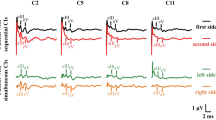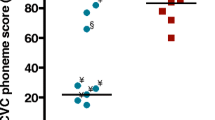Abstract
Myelination of the 8th nerve and Maturation of the brainstem have a direct relationship to the function of hearing and speech development. If disease conditions affect the pathway daring early childhood, damage results in deficit of auditory and speech skills. We have studied this by employing auditory brainstem evoked potentials in 11 children (1 month to 2 years). From 1 month to 6 months, there is no evidence of significant myelination at ABER testing. It becomes clearly evident soon after and it is completed at 2 years of age which is comparable to adult values. The cochlea fully develops at birth as evidenced by wave I latency which is comparable to adult values.
Similar content being viewed by others
References
Chiappa, K.H. (1983). Evoked potentials in clinical Medicine, pp. 138–180, Raven Press, New York.
Deka, R.C. (1985). Auditory brainstem evoked potentials in at-risk children (under preparation).
Deka, R.C, Kacker, S.K. (1985). ABER in Meniere’s Disease.Indian J. Otolaryngology, (in press).
Fujikawa, S.K., Weber, B.A. (1977). Effects of increased stimulus on human brainstem electric response audiometry as a function of age.J. Am. Audiol. Soc. 3: 147–150.
Hecox (1975). Electrophysiological correlates of human auditory development. In infant perception ; From sensation to cognitionl: Vol. II: Perception of space, speech and sound. Edited by L. B. Cohen and P. Salapatek, pp. 151–191.Academic Press, New York.
Hecox, K., Galambos, R. (1974). Brainstem auditory evoked response in human infants and adults.Archives of Otolaryngology.99: 30–33.
Mokotoff, B., Shulman-Galambos, C., Galambos, R. (1977). Brainstem auditory evoled responses in children.Arch. Otolaryngol. 103: 38–43.
O’Donovan, C.A., Beagley, H.A. H.A. Shaw, M. (1980). Latency of brainstem response in children.British —. Audiology 14: 23–29.
Smith, L.E., Simmons, F.B. (1982). Accuracy of auditory brainstem evoked response with hearing level unknown.Ann. Otol. Rhinol. Laryngol. 94: 266–267.
Sohmer, H., Feinmesser, M. (1973). Routine use of electrocochleography on human subjects.Audiology 12: 167–173.
Starr, A., Amile, R.N., Martin, W.H., Sanders, S. (1977). Development of auditory function in newborn newborn infants, revealed byauditory brainstem potentials.60: 831–839.
Suzuki, J.I., Kodera, K., Kaga, K. (1982). Auditory evoked brainstem response. Assessment in Otolaryngology,Ann. N. Y. A. cad. Sci. Vol.388: 487–495.
Author information
Authors and Affiliations
Additional information
This work was partly supported by a Institute’s Research Research Grant and also by the N.E.S. India.
Rights and permissions
About this article
Cite this article
Deka, R.C., Deka, D. & Kacker, S.K. Maturation of cochlea, auditory nerve and brainstem as observed by auditory brainstem evoked potentials in human infants and children. Indian J Otolaryngol 38, 56–58 (1986). https://doi.org/10.1007/BF03020140
Issue Date:
DOI: https://doi.org/10.1007/BF03020140




